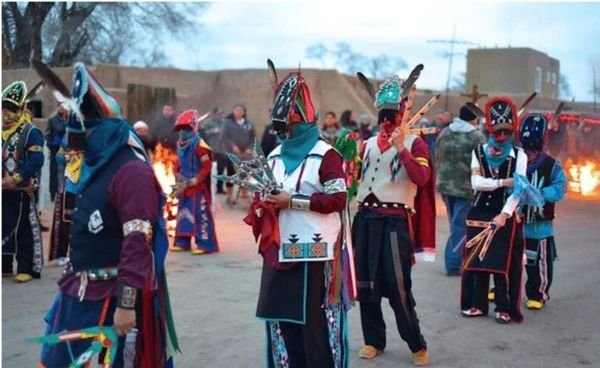Ohkay Owingeh. Tribal Lakes and Sangre de Cristo Mountains, Rio Arriba County
Current Population: 6,748
Location: 12,000 acres located north of Española in Rio Arriba County
Language: Tewa
Early Societal Structure: Agrarian, Exogamous, Matrilineal clans with ritual patrimoieties and dual kivas

Click to expand

O'kke Owingeh people have lived in the Rio Grande Valley since 1200 A.D. They built two villages at the confluence of the Rio Grande and the Rio Chama, one on each side of the river: O'kke Owingeh and Yungé Owingeh.
Its people were so powerful that only an O'kke native could declare war for the Pueblo Indians.
The village center, known as Owe’neh Bupingeh, has been occupied for over 700 years. It consists of four earthen plazas surrounded by interconnected handmade adobe dwellings coated in mud plaster. It is the setting for ritual observances and is the traditional spiritual center of the community.
Colonizers named this place San Juan Pueblo. The tribe returned to its traditional name in 2005.
Occupied
In 1598, Oñate brought to Yungé Owingeh a caravan of Catholic missionaries, a thousand soldiers, colonists, and Tlaxcalans. The expedition included cattle, sheep, goats, oxen, and horses. The people of Ohkay Owingeh were hospitable to the Spanish.The event helped reunited the two villages. Oñate made this place the capital.
Ohkay Owingeh is where Oñate brought 507 people of Acoma, following the Acoma Massacre. Women who were ages 12-25 and younger men were enslaved for 20 years.
Leading the Revolt
Po'Pay, who coordinated the Pueblo Revolt, was a holy man from Ohkay Owingeh. A marble statue of Po'Pay is at the National Statuary Hall. It was carved by Cliff Fragua of Jemez Pueblo.
Po’Pay was born around 1630. Hos given name, Popyn, means “ripe squash” in the Tewa language. As an adult he became a religious leader and was responsible for healing as well as for his people’s spiritual life. He also knew of his people’s suffering under Spanish settlers, who forced them to provide labor and food to support the Spanish community. The Spaniards also pressured them to give up their religion and way of life and to adopt Christianity—those found practicing their religion were tortured and sometimes executed.
In 1675, Po’pay and 46 other Pueblo leaders were convicted of sorcery; he was among those flogged, while others were executed. In 1680 Po’pay organized the Pueblo Revolt against the Spanish. According to legend, to coordinate the timing of the uprising, he and his followers sent runners to each pueblo with knotted deerskin strips. One knot was to be untied each day, and the revolt would begin on the day the last one was untied. However, the Spaniards arrested two of the runners, and the pueblos were quickly notified to accelerate the revolt. The attacks began on August 10, two days before the last knot would have been untied. The Spaniards took refuge at Santa Fe; the besieging Indians cut off their water supply but soon permitted them to leave the area. The Pueblo Revolt helped to ensure the survival of the Pueblo culture and shaped the history of the American Southwest.
Modern Day
The mission of Ohkay Owingeh is:
To protect and preserve the traditional and cultural values of its people, by initiating and maintaining integrated program strategies equipped with the knowledge and technical tools for environmental management, monitoring, implementation of the Tribes’ Surface Water Quality Standards and establish a Resource Management Program with baseline information to assess and maintain the traditional and cultural values of the people of Ohkay Owingeh.
Ohkay Owingeh is the headquarters of the Eight Northern Indian Pueblos Council.
Revitalizing Culture Through Housing
The Ohkay Owingeh Housing Authority, working closely with the tribal council, embarked on a complex, long-term project to revitalize the buildings in Owe’neh Bupingeh. The goal was to bring families back to live around the plazas. A consensus emrged that it was important to save the buildings since they "contained the breath and sweat of our people" but that modern amenities should be added. The tribal council and tribal realty department established a transparent procedure for tribal members to record their claims on homes and to transfer ownership shares, making it possible for renivations to begin.
The Tribal Council was uncomfortable involving state and federal agencies in a project that dealt with the sacred and spiritual sites. They were able to work with the numerouspartner agencies on their own terms, finding a way to balance the community's goals and vision with agency mandates.
Lessons learned through the project include:
Rebuilding the physical and historic core of a community can help rebuild relationships, revive cultural practicesm and strengthen the nation.
Investments in community engagement and planning are essemtial tom sustaining communities.
A strong vision and clear programmatic goals ensure the success of intergovernmental agreements and reflect sovereignty in action.










